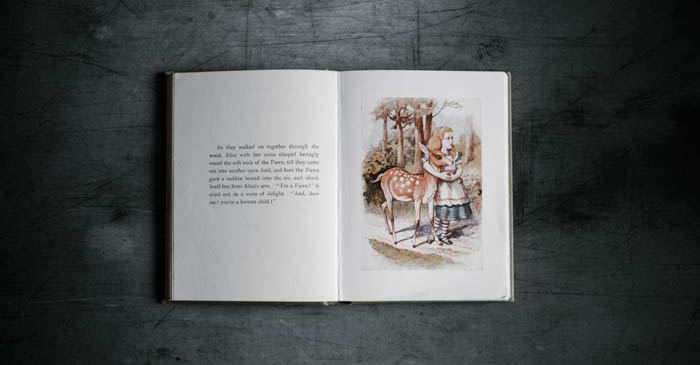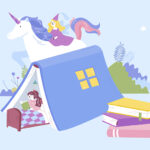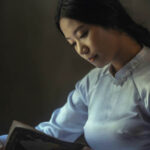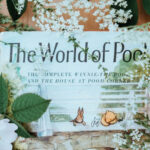Discussing the Current Status of Korean Picture Books
A visual language that captivates all generations
From the beginning of the 2000s, Korean picture books have been displaying a dramatic change in their identity, and it is even difficult to predict their next transformation. In the background was the growth of authors who have been honing their professional illustrating skills since the 1990s and the introduction of new authors in the field influenced by them. Also, the expansion of the readership has influenced the trend as generation Z has begun to recognize picture books as a new media. The most distinctive characteristic of Korean picture books is that there’s not only an increasing number of aesthetic aspects but also metaphoric and experimental attempts. Picture books with rich expressions and aesthetic mechanisms are becoming a new tool for communication that reaches all generations.
Picture books are growing their readership as generation Z has begun to recognize them as a new media.
In particular, the world saw the value of Korean picture books in 2020 when author Baek Hee-Na won the Astrid Lindgren Memorial Award (ALMA). Her exquisite writing style opened a new chapter of picture books displaying humanitarian themes. For instance, books like Magic Candies (Bear Books Inc., 2017) and I Am a Dog (Bear Books Inc., 2017) introduce movie-like stories about solitude and solidarity through the sublime atmosphere, looks, and body movements of the main characters. Also, the sweet goodies, playfulness, and unrivaled charm of Sculpey act as a gateway between reality and a guide along the path which modern society should pursue regardless of generation.
Authors who won at the Bologna Children’s Book Fair and are continuing to present their unique artistic style are also notable. For example, author Cha Eun-Sil wrote I Built a House (HYANG, 2021) following What is Happening (HYANG, 2019), where she asks pointed questions with back-to-back stories that arouse curiosity. Those questions linger in our heads long after we finish the books and make us think about what’s most important in our lives. Meanwhile, author Cho Seul-Ki’s A Caterpillar Who Experiences Rain For the First Time and a Ladybug Who Has Experienced Rain Once (HYANG, 2020) focuses on “difference.” The linguistic sense that takes a different perspective towards the same subject makes readers have fun while reading. Also, the pictures – a mixture of lines and spaces – help us imagine freely, and the different viewpoints toward “rain” pose a question to our perceptions.
Author Jo Won-Hee is continuously growing her art world, winning the Bologna Ragazzi Award with Teeth Hunters (IYAGIKOT PUBLISHING, 2014). One of the biggest characteristics of her style, repeating simple images, clearly uncovers complex emotions, and is effectively used to carefully describe the delicate sentiments of human relationships rather than the people themselves. Such repetition of simple images creates a strong image, which possesses the power to consistently push forward the detailed emotions until the end of the story. In particular, soft colors and blank spaces used in Hate (Manman Books, 2020) and Our House (IYAGIKOT PUBLISHING, 2021) make the readers focus on the emotional feelings inside the simple but thick lines, shedding light on children’s psychology and social issues.
Reproduction and creation of Korean-style images
The vitality of old stories comes from their reconstruction and in which modern meanings are newly created while the old virtues are kept intact. There are more picture books today that use folklore to recapture the witty humor unique to Korea. For example, Here Comes the Bogeyman (Sigong Junior, 2007) written and illustrated by Park Yeon-Cheol, emphasizes the overthrown order of power, making readers laugh and feel a sense of liberation. Meanwhile, Spooky Stories (Changbi, 2020), written and illustrated by Lee Gab-Kyu, offers narrative fun using the Korean tale “The tiger and the dried persimmon” as inspiration, delivering a message that goes beyond generations. Furthermore, what makes us proud of Korean picture books for making a step forward is how the author creates a boundary between reality and fantasy, where a wild animal appears and disappears, and turns it into a type of play.
On the other hand, An Old Seal Grandmother (Kidari Publishing, 2020) written by Oh Mi-Kyung and illustrated by Lee Myung-Ae and Dalhangari (meaning Moon Jar in Korean) are picture books that use a good mixture of Korean materials for artistic aesthetics and literary description. In the book An Old Seal Grandmother, illustrator Lee Myung-Ae used the Jeju ocean with colorful images as the background to express “Haenyeo” (female divers in the Korean province of Jeju), designated as a UNESCO Intangible Cultural Heritage, in a realistic and symbolic way. The images from under the Jeju ocean embrace the meaning and values of life, as they move on to the unyielding life of “halmang” (meaning “grandmother” in the Jeju dialect) and then to the ocean and “Jeju halmangs” seen from the eyes of a child.
Meanwhile, Dalhangari (Darim Books, 2020), written and illustrated by Cho Young-Ji, calmly unfolds a story about the Korean War from the viewpoint of the Moon Jar, which represents Korean sentiment. The “Dalhangari,” which resembles a “Water jar (read as “mulhangari” in Korean)” made by Kim Hwan-Ki, one of the most prominent artists in Korea, not only holds Korean sentiments but also warmly enfolds the scars from the war. Wars completely destroy the notion of time and space. Wars make everyone not only lose their space but also suffer from the damaged relationships and shared, old memories that they used to have with people around them. The book Dalhangari well-depicts the fact that there’s still life amidst the memories of pain. These picture books are the bridge that connects the past and present with shared memories and can be meaningfully interpreted from the perspective of modern life as well.
Korean picture books have also made a big stride forward in terms of the system and concreteness of how they express images. For instance, Rain Shower and Mudfish (Changbi, 2020), written by Lee Sang-Kyo and illustrated by Kim Se-Hyun, is a picture book where texts and pictures create a poem. It is a delicately drawn book that describes the rain showering on the indigenous landscape of Korea and the nature of mudfish that ascend the river. The pictures drawn with “meok” (inkstick, a type of solid ink used for calligraphy and brush painting in several East Asian countries) show the texture and depth of raindrops, and the colors in the background emphasize the dynamic, comic movement of the mudfish. Also, in the book Glowing Ghost (Safari Books, 2020) written by Lee Chun-Hee, illustrator Han Byung-Ho who created “dokkaebi” (Korean goblins, nature deities, or spirits possessing extraordinary powers), unfolds old stories related to the “glowing ghost” with a spooky but clumsy character. The book has reproduced and added new Korean-style images to the old stories, forging a symbolic system in both literary and artistic aspects, moving closer to young readers.
More personal narratives in books
More picture book authors are using personal narratives in their works these days. They tend to consciously raise a question in the relationship between their work and readers, and this has led to more diverse materials and topics used for picture books. Picture books that serve as a bridge between children and adults do not draw a line between their different worlds. Following this trend, more picture books are covering topics such as sadness, pain, and death, which have been avoided in children’s literature until not so long ago. Some of them leave a message to their readers that the birth of a being creates a family, but in the end, there’s death which they will have to inevitably prepare for. Death in picture books is like traveling to another new world as a rite of passage. For example, The Day of the Funeral (Mirae I Books, 2018), written by Sun Ja-Eun and illustrated by Choi Hyun-Mook beautifully describes Korea’s traditional funeral and Me and My Grandpa (Bear Books Inc., 2019) written by Shin Sun-Jae and illustrated by Lee Myung-Ae shows how the child overcomes fear through the play she used to enjoy with her grandfather and naturally accepts the meaning of death. How the book describes death surpasses a mere expression of birth and death, and induces readers to think of death in various ways. Picture books’ way of describing death goes beyond including the author’s philosophical message. They have a unique language that only children can understand. Hence, children can perceive the meaning of death as a course of facing their true self inside themselves.
Meanwhile, one thing that stands out in the picture book A Bride with a Paddle (IYAGIKOT PUBLISHING, 2019) written and illustrated by Oh So-Ri is the illustration that expresses the girl’s free emotions. Anyone could easily imagine that a whole new journey will begin by looking at her where she heads to the ocean with a paddle while wearing a dress. Her courageous steps breaking free from the notions and social conventions of the world blend with diverse colors, making the readers think about their true self, going beyond giving a “gender swap” effect. Meanwhile, Courage (Dalgrim (Yellowpig), 2019), written and illustrated by Park Se-Kyung, asks modern people living a busy life what true happiness is. In the format of a fable, the book encourages its readers to “find the true self undiscovered within” through the process of asking and answering questions about what courage they need right now.
Also, Guard Up (Manman Books, 2017), written and illustrated by Goh Joung-Soon, who is sensitive to the inner self’s voice, caused a great sensation as soon as it was published. How the main character never stops putting their guard up amidst the frustrating moments in the ring, reflects us living out the harsh, challenging days, emphasizing “how we stand up again.” Meanwhile, The Wired Elephant (Manman Books, 2018) well-depicts how to “properly say goodbye” through the story of a little elephant and a boy named “Dehet,” and A Story of an Old Mountain Goat (Manman Books, 2020) slowly draws out the last moment of life. Picture book authors grow up together with their books, unfolding their narratives inside them. Recently published The Shadow (Gilbut Kid, 2021) is a picture book that recreated Hans Christian Andersen’s The Shadow with refined colors and a mixture of black and white. This book achieved “openness” by expressing the passing of a being through black and white images. Hence, it allows readers to continue thinking about their own story even after the end of the book.
Adding to the aesthetics of Korean picture books, there are more metaphoric and experimental works.
The picture book industry in Korea is showing a clear ecological change in that new types of authors and publishers are appearing with more diverse topics. While the children’s world shown in picture books of the past could be called the “heterotopia (a combined word of ‘heteros’ meaning ‘different’ and ‘topos’ meaning ‘place’),” those of today summon children from the physical world and walk together with them. Also, they are expanding their horizon as picture books by breaking free from the social perception that “picture books are only reserved for children” to “picture books grow together with children.” The vibrant changes of Korean picture books are still ongoing.
Written by Jo Sung-Soon (Children’s Literature Critic)












